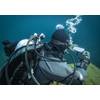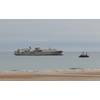Least Known Navy Activity? Underwater Shipwreck Archeology
Robert S. Neyland, Ph.D., director of the Underwater Archeology Branch (UAB) of the Naval History and Heritage Command (NHHC) in Washington, D.C., manages the people who protect more than 17,000 ship and aircraft wrecks around the world.
The UAB houses a collection of more than 3,000 artifacts recovered from sunken military craft sites, and an artifact loan program of 6,000-plus items to national and international museums and other qualified facilities throughout the world.
The branch itself was created in 1993 through the Department of Defense Legacy Resource Management Program funds. Robert Neyland, Ph.D., followed soon after. Neyland, a native of Palestine, Texas, earned his doctorate and master's degrees in anthropology through the Department of Anthropology, Nautical Archaeology Program at Texas A&M, 1996 and 1994, respectively. He also holds another master's degree in public administration and planning from the University of Texas at Tyler and a bachelor's degree in wildlife science from Stephen F. Austin University.
So what did it take to get this Texas boy out of Texas? Mixing his love for diving with archaeology. He's traveled the world, diving some of the world's oldest shipwrecks. His scientific expertise and experience in management led him on assignment from Texas A&M to the Naval Historical Center in 1994 to assist the Navy in the development of policies and a program in underwater archaeology. The work was so intriguing he left Texas A&M to work at the branch as a federal government employee in 1996.
While working as the Branch Head of the new Underwater Archaeology Branch, Neyland's unique experience led South Carolina officials to request the Navy to loan him to the State under the Intergovernmental Personnel Act (IPA) in 1998 to assist them with the archaeological recovery and documentation of the submarine H.L. Hunley discovered off the coast of South Carolina.
His Navy work has taken him to dives on Revolutionary War ships in Maine, surveys of WWII wrecks off the beaches of Normandy, France, and rare downed aircraft under the waves off the Marshall Islands. He's led the Navy archaeology team seeking the resting site of World War II submarine USS Pompano, which sank somewhere off the coast of Japan.
Diving for archaeology, however, isn't always in pristine recreational areas such as the waters of the Caribbean or Mediterranean Seas.
"The visibility for diving isn't that great in harbors and rivers," Neyland said. "But we dive where the wrecks are."
Source: Naval History and Heritage Command
















 February 2024
February 2024



